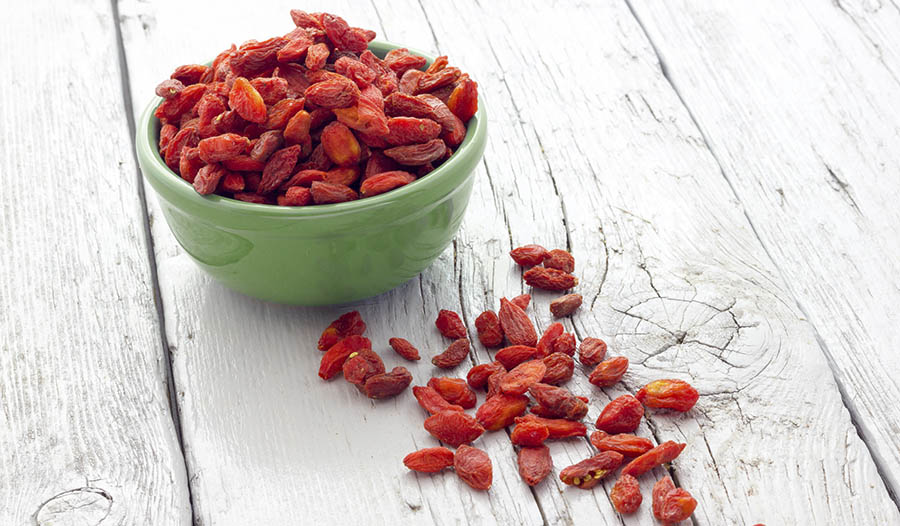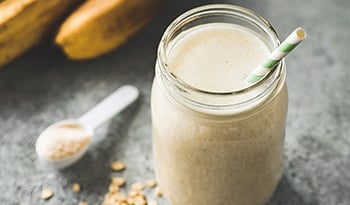Goji Berry Benefits + 7 Easy Recipes That Pack a Nutritious Punch
DISCLAIMER:This blog does not intend to provide diagnosis...
- In this article:
- What Are Goji Berries?
- Goji Berries Nutritional Information
- The Health Benefits of Goji Berries
- Health and Longevity Benefits
- Blood Sugar Benefits
- Antioxidant Benefits
- Anti-Aging Benefits
- Healthy, Easy Recipes with Goji Berries
- 1. Goji Berry Oatmeal
- 2. Goji Berry Truffles
- 3. Spicy Goji Berry Tomato Soup
- 4. Goji Berry Dried Fruit Salad
- 5. Dried Fruit Granola
- 6. Nutritional Goji Juice Smoothie
- 7. Flavorful Dried Fruit Shake

Originally posted January 2019 / Updated March 2023
What Are Goji Berries?
Goji berries are orange-red, oval-shaped fresh berries native to Asia. The berries grow on a shrub (Lycium barbarum) and are also known as wolfberries. Most consumers are familiar with dried goji berries that look like what would be red raisins and tastes a bit like a sweet version of cranberries. In addition to dried Goji berries, powdered and juice forms serve as a versatile way to add nutritional value to the diet.
Goji Berries Nutritional Information
About five tablespoons or one ounce (28 grams) of dried goji berries provide:
- Calories: 98
- Protein: 4 grams
- Fat: 0.1 grams
- Total Carbohydrates: 21.6 grams
- Dietary fiber: 3.6 grams
- Sugar: 13 grams
- Vitamin A (from carotenes): 7,500 IU
- Vitamin C: 15 mg
- Iron: 1.9 mg
One reason that goji berries are healthy is that they, like many other fruits, contain a number of vitamins and minerals. These include:
The Health Benefits of Goji Berries
Health and Longevity Benefits
Goji berries have traditionally been used in Asian countries to boost health and longevity. This fruit is becoming increasingly popular among health-conscious diners in the western world.
One reason that goji berries are healthy is that they, like many other fruits, contain many vitamins and minerals. Goji berries provide a good amount of protein for a fruit and a full range of amino acids. Specifically, goji berries contain all eight amino acids essential to the human diet.
Goji berries are also a good source of particular forms of dietary fiber and a wide range of phytochemicals, especially carotenoids and polyphenols.
Eating goji berries delivers a burst of nutrition to the body, but these berries have larger health-promoting effects.
Blood Sugar Benefits
In human clinical studies, consuming goji berries with a healthy dietary pattern has been shown to improve blood sugar control, blood cholesterol levels, blood pressure, biomarkers of oxidative stress, inflammation, and markers of cardiovascular health.1-3 Typically, the amount used is between 14-30 grams per day or roughly 3 to 6 tablespoons of dried goji berries. The results of these clinical studies are impressive. For example, in a 16-week controlled trial, forty middle-aged and older adults consumed 15 g/d whole, dried goji berries with their main meals.4 Researchers looked at several biomarkers of vascular tone, blood lipid levels, and blood pressure. Compared with the control group, these markers were all significantly improved with goji berry consumption.
Antioxidant Benefits
Researchers have noted better antioxidant benefits through synergistic effects in fruits and herbal products from a complex mixture of phytochemicals compared to one single phytochemical.5
One of the major disorders related to oxidative damage is aging-related macular degeneration (ARMD). The macula is the area of the retina responsible for fine vision. AMD is a significant cause of blindness in adults. Macular degeneration is linked to lower levels of the carotenoids lutein and zeaxanthin.
A biomarker that predicts AMD is measuring the macular pigment optical density (MPOD), which reflects the level of lutein and zeaxanthin in the macula. A clinical study examined the effects of goji berry intake, as a source of zeaxanthin, on MPOD and the level of carotenoids in the skin of healthy individuals. The 27 participants, between the ages of 45 to 65 years old, consumed either 28 g of goji berries or a dietary supplement containing 6 mg lutein and 4 mg zeaxanthin (LZ) five times weekly for a total of 90 days. After 90 days, the MPOD in the goji berry group was significantly elevated. In contrast, there were no changes in MPOD in the LZ group. Skin carotenoids were also considerably increased in those ingesting goji berries but not in the LZ group. These results indicate that eating goji berries may offer greater protection against damage to the macula and AMD.6
Anti-Aging Benefits
Goji berries' anti-aging effects are fascinating. While the various phytochemicals such as carotenoids and polyphenols (including flavonoids) are known anti-aging compounds, what makes goji berries unique are the dietary fiber components and key anti-aging compounds.5 These fiber compounds have been shown to exert their antioxidant effects and regulate the immune system and cellular protection.7
In Traditional Chinese Goji berries have been used to increase longevity and for the benefits to liver, kidney, and vision since ancient times. And this use has some scientific support. In a double-blind, placebo-controlled trial in 60 older healthy adults (55 to 72 years old) those taking a 120 ml per day of a goji berry juice equivalent to at least 150 g of fresh fruit for 30 days showed improved immune function and a significant increase in general feelings of well-being.8 They were also less fatigued and showed a tendency for improved short-term memory and focus. There were no changes for any parameter in the placebo group. These results support the anti-aging effects of ingesting goji berry juice or dried berries.
Healthy, Easy Recipes with Goji Berries
In traditional Chinese cuisine, dried goji berries are often cooked before consumption. They are popularly used in Chinese soups, herbal teas, herbal formulas, and wine or juice. Goji berries enhance both sweet dishes and savory ones. The following recipes can provide a great starting point for learning to cook with goji berries.
1. Goji Berry Oatmeal
Ingredients:
- 4 cups water
- 1/2 cup dried goji berries
- 1 cup steel-cut oats
- 1 tsp. salt
- 1/2 tsp. ground cinnamon
- 1/4 tsp. ground cardamom
- Milk (optional)
- Maple syrup (optional)
Instructions:
- Add all ingredients to a saucepan. Bring the mixture to a boil.
- Reduce heat. Simmer for 25 minutes. Stir frequently.
- Remove from heat when the water is absorbed, and the oats are tender but not mushy.
- Scoop oatmeal into four bowls. Top the cereal with milk or maple syrup if desired and enjoy.
2. Goji Berry Truffles
Powdered goji berries add color and flavor to the outside of these sweet balls. This recipe makes about four servings.
Ingredients:
- 1 cup hazelnuts
- 8 Medjool dates
- 4 Tbs. cacao powder
- 6 Tbs. goji berry powder, divided
- 2 Tbs. coconut oil
Instructions:
- Add all ingredients except 2 Tbs. of the berry powder to a food processor.
- Grind the ingredients until they become a thick paste.
- Roll 1 Tbs. of the mixture at a time into a ball.
- Pour the remaining 2 Tbs. of goji powder into a small bowl. Roll each ball in the powder.
- Refrigerate for 30 minutes before serving.
3. Spicy Goji Berry Tomato Soup
Ingredients:
- 2 cups dried goji berries
- 3 cups water
- 2 large onions, diced
- 2 Tbs. olive oil
- 1 28-ounce can whole tomatoes
- 1.5 tsp. ground cumin
- 1 tsp. crushed red pepper flakes
- 1 tsp. ground coriander seed
- 2 Tbs. vegetable bouillon powder or paste
Instructions:
- Soak the goji berries in the water for about 10 minutes.
- Meanwhile, sauté the oil and onions in a pot.
- Mix in the tomatoes and seasonings. Heat for two minutes.
- Transfer the water and berries to the pot. Add the broth powder.
- Simmer for 10 minutes.
- Use an immersion blender to puree the soup.
- Divide the soup into bowls and serve.
4. Goji Berry Dried Fruit Salad
Dress up a simple green salad with a scoop of quinoa and a sprinkle of dried fruit. This recipe serves two people.
Ingredients:
- 1 cup shredded greens
- 3/4 cup dried quinoa
- 1/2 cup prepared oil and vinegar salad dressing
- 3 green onions, white and green portions
- 1 small chopped tomato
- 1/4 cup dried goji berries
- 1/4 cup roasted pepitas
- 1/4 cup dry-roasted edamame
Instructions:
- Cook the quinoa according to package directions. Allow cooling slightly.
- Chop the tomato and green onions.
- Divide the greens between two plates.
- Toss the tomatoes and onions over the greens.
- Scoop a large spoonful of quinoa onto each plate.
- Drizzle salad dressing over the quinoa and greens.
- Sprinkle dried berries, pepitas and edamame over the salads.
5. Dried Fruit Granola
Ingredients:
- 2 cups rolled oats
- 2 Tbs. coconut oil
- 6 Tbs. maple syrup
- 1/2 cup unsweetened coconut flakes
- 2/3 cup chopped pistachios
- 1 Tbs. cinnamon
- 1 tsp. salt
- 2/3 cup dried goji berries
Instructions:
- Preheat oven to 350 degrees Fahrenheit.
- Place the oats in a large bowl.
- Heat oil, syrup, coconut, pistachios, cinnamon and salt over the stove until well-blended.
- Pour syrup mixture over the oats. Stir to combine well.
- Spread the oat mixture evenly over a baking sheet.
- Bake in the preheated oven for 45 minutes. Stir once or twice during baking.
- Sprinkle granola on yogurt and enjoy.
6. Nutritional Goji Juice Smoothie
Ingredients:
- 1 cup goji berry juice
- 1 cup frozen berries, such as blueberries or raspberries
- 1/4 cup unsweetened coconut flakes
- 1/8 cup dried goji berries
Instructions:
- Add all ingredients to a blender.
- Puree until the mixture is smooth.
- Pour the smoothie into a glass and enjoy.
7. Flavorful Dried Fruit Shake
Ingredients:
- 1 3/4 cups water and 1/4 cup dry milk powder or 2 cups milk
- 2 frozen bananas, chopped in large pieces
- 1/4 cup dried goji berries, plus extra for garnish
- 2 Tbs. cacao nibs, plus extra for garnish
- 1 Tbs. chia seeds
- 1 tsp. vanilla extract
- 1/4 tsp. salt
Instructions:
- Place all ingredients in a blender and mix until smooth.
- Pour shake into two glasses.
- Garnish with additional berries and nibs before serving.
References:
- Toh DWK, Low JHM, Kim JE. Cardiovascular disease risk reduction with wolfberry consumption: a systematic review and meta-analysis of randomized controlled trials. Eur J Nutr. 2022 Apr;61(3):1177-1186.
- Liu H, Cui B, Zhang Z. Mechanism of glycometabolism regulation by bioactive compounds from the fruits of Lycium barbarum: A review. Food Res Int. 2022 Sep;159:111408.
- Ma ZF, Zhang H, Teh S, et al. Goji Berries as a Potential Natural Antioxidant Medicine: An Insight into Their Molecular Mechanisms of Action. Oxid Med Cell Longev. 2019 Jan 9;2019:2437397.
- Toh DWK, Xia X, Sutanto CN, et al. Enhancing the cardiovascular protective effects of a healthy dietary pattern with wolfberry (Lycium barbarum): A randomized controlled trial. Am J Clin Nutr. 2021 Jul 1;114(1):80-89.
- Masci A, Carradori S, Casadei MA. Lycium barbarum polysaccharides: Extraction, purification, structural characterisation and evidence about hypoglycaemic and hypolipidaemic effects. A review. Food Chem. 2018 Jul 15;254:377-389.
- Li X, Holt RR, Keen CL, Morse LS, Yiu G, Hackman RM. Goji Berry Intake Increases Macular Pigment Optical Density in Healthy Adults: A Randomized Pilot Trial. Nutrients. 2021 Dec 9;13(12):4409.
- Gao Y, Wei Y, Wang Y, et al. Lycium Barbarum: A Traditional Chinese Herb and A Promising Anti-Aging Agent. Aging Dis. 2017 Dec 1;8(6):778-791.
- Amagase H, Sun B, Nance DM. Immunomodulatory effects of a standardized Lycium barbarum fruit juice in Chinese older healthy human subjects. J Med Food. 2009 Oct;12(5):1159-65.

 By Dr. Michael Murray, N.D.
By Dr. Michael Murray, N.D. 


